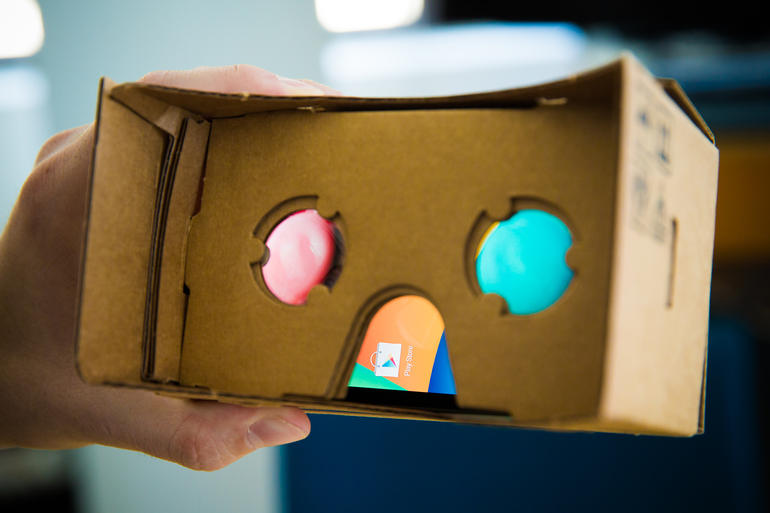
James Martin/CNET
When Google took over downtown San Francisco last year to host its big annual developer conference, robots served beers to its most devoted acolytes while Billy Idol belted out “White Wedding.”
But this year Google seemed intent on keeping this a decidedly low-key affair so as not to offend the neighbors. That’s not to say that it was cheap, but it certainly wasn’t as ostentatious as in previous years. Google replaced the ’80s rock star and extravagant automatons with a selection of local bands, food trucks, restaurant pop-ups, and a “silent rave” in San Francisco’s Yerba Buena park as attendees danced to synced-up music piped in through headphones. Plush four-poster beds dotted the grass, inviting partiers to kick back and relax.
The change in tone hardly seems accidental. Held earlier this week, Google’s annual I/O tech-fest is the company’s highest-profile event. And this year, as Google presented an ambitious plan to spread Android beyond the confines of your phone and tablet, the company finds itself a regular target of local protesters frustrated with a massive influx of wealthier tech employees who they say are responsible for driving up the cost of living in the Bay Area.
The company’s strategy — both in its pitch to developers and its approach to the conference itself — seems to have been to go back to basics. For some developers in attendance this year, the event was less of a romp, and more a low-key rendezvous. One developer, who asked to remain anonymous because he didn’t want to mar potential business relationships with Google, called this year’s conference “sedated.”
“Last year, there was Billy Idol and huge screens, and vehicles you could drive [at the after party],” said the developer, who has attended I/O five times. “This year there were four food trucks.”
Google declined to comment on this story.
While I/O is a conference for developers — Apple, Microsoft, and Facebook stage similar gatherings each year — the goal is to do more than just to woo the coding digerati. Scott Kessler, an equity analyst at SP Capital IQ, said another goal is for these respective big companies to sketch out their vision for larger constituencies.
“They have become equivalent to their State of the Union,” he told CNET.
Google, a company that proclaims “don’t be evil” as a core value, is clearly sensitive to the way it’s perceived by the wider public, especially these days when critics are protesting its growing presence in San Francisco. The protests often condemn the shuttles that ferry employees of Google, Facebook, and other tech companies from their homes in the city to corporate campuses in Silicon Valley. Colloquially, the shuttles are known simply as Google buses.
So it was that protesters staged interruptions at different points in Google’s keynote. One protester said she was evicted from a seven-apartment building that Google attorney Jack Halprin bought two years ago in San Francisco’s Mission District. The other protester, louder and less coherent, warned the crowd that Google was “building totalitarian machines that kill people.”
Google I/O (pictures)
See full gallery
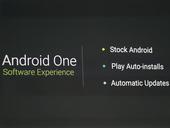

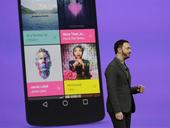

“Google Glass and Google buses have become sort of targets for people who blame inequality on tech,” said Margaret Weir, a sociology professor at the University of California Berkeley, adding that the tamer event could have been an exercise in the company’s discretion to tread lightly. “The last things they’d want to do [with this conference] is add fuel to those particular issues.”
The criticisms haven’t fallen on deaf ears. The company touts that Google employees volunteered 2,000 hours of community service last year and the company donated $20 million to Bay Area nonprofits. The company in February also donated $6.8 million to the city to allow youth from low income families to ride public transportation for free.
At the show this year, sessions on women in tech and cutting-edge projects designed to create an emotional connection through tech highlighted the company’s loftier goals.
Other big companies have also tried to pitch in. Twitter, which receives a major tax break for having its headquarters in San Francisco’s rundown Mid-Market neighborhood, holds “Days for Good,” in which its employees volunteer in the area, as part of a community benefits agreement the company has with the city.
In a rare comment about the controversy, CEO Larry Page said that while he understands the reality of the social problems facing San Francisco, Google is often targeted because of its size.
“To some extent we’re being used as a way to attract attention. We had protests about the CIA and I don’t know what else, but it didn’t make any sense to me with respect to the company,” Page told the New York Times. “As a big company we’re a target for some of these things. But I think people have legitimate issues with it as well.”
No talk of ‘moon shots’
But the modest tone of the party isn’t the only way Google stripped things down for the conference this year. Yes, I/O is a conference for developers, but for the past two years, that focus has been overshadowed by other goings-on at the event. Last year, Page came out for a surprise question-and-answer session, and two years ago, co-founder Sergey Brin famously demoed the Google Glass smart headset by having skydivers jump out of a blimp onto the venue.
This year’s Google I/O didn’t feature even a single keynote appearance by either of the company’s two top leaders, though Page was seated in the front row, and both he and Brin were reported to be seen moving around the conference on Wednesday — perhaps in incognito mode? This year the spotlight was pointed at Sundar Pichai.
The senior vice president in charge of Chrome, Android, and Apps divisions highlighted how Android was changing from a smartphone and tablet platform to a mobile platform — literally. Android is being retooled to power the entertainment systems on cars, to run smartwatches, and to make transitioning from the Web to your phone to your TV as smooth as water pouring into a glass.
There’s nothing glitzy about margin width in apps, and even less when revealing to a crowd of more than 6,000 people how server infrastructure changes will make their apps run better, but Google plowed through its two-and-a-half hour keynote all the same.
“This year they actually had details of the new design, and the cloud services,” said Silvia Curioni, who develops AllTheCooks for Android and iOS and has attended three of the past four Google I/O conferences. “I don’t remember seeing something so technical at the keynote before.”
Google I/O 2014: Android wearables coming to your wrist (pictures)
See full gallery
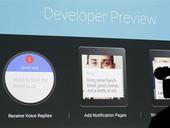

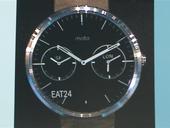

The emphasis on the finer points of building for Android didn’t bother Twilio and Google Glass developer Jonathan Gottfried, either.
“A big thing this year was the stricter design guidelines for developers,” he said, referring to Material, Google’s design plan for a more unified look across apps and services. “Android [currently] doesn’t feel like a clean experience because of the differentiation between phones and operating systems.”
In fact, longtime Google observer Danny Sullivan commented that by focusing the keynote on a deep look at what’s new for Android, Google set the tone for keeping its developer army from getting distracted from the company’s ambitious “moon shot” products, which include driverless cars and Wi-fi beaming balloons.
“The argument from Apple is that Android is fragmented and this is a problem for consumers,” Sullivan said. “It’s not a question of whether your operating system is the latest; it’s a question of whether it runs the apps you want to run. People don’t focus on the fragmentation because they still get their apps,” he said.
Although the tone of the show was less glam and more guts, Google didn’t shy away from its famous giveaways. Google I/O has become the Oprah Winfrey show of tech conferences, with the company giving away expensive gadgets to eager developers. Freebies in the past included Nexus smartphones and tablets, and a $1,450 Chromebook Pixel laptop. This year had its own set of marquee giveaways, including two smartwatches — one being the hotly anticipated Moto 360 smartwatch when it comes out later this summer.
But the headline-grabbing freebie was far thriftier: a slab of cardboard. Inventively called Google Cardboard, it’s a do-it-yourself kit that you slide your smartphone into for making a cardboard virtual reality headset, made from around $30 worth of parts.
Google Cardboard appealed to many developers’ bootstrap aesthetics. It fits the story that Google is trying to tell its die-hards at the show — and the rest of the world, for that matter: We may be one of the most powerful tech companies in the world, but we’re still just like you at heart.
